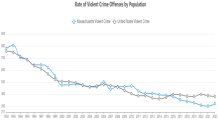Violent crime across the U.S. decreased last year, but it went up in Massachusetts, according to data in the FBI’s annual crime report released Monday.
For every 100,000 people in the Bay State, the data shows 322 were victims of violent crime in 2022. The previous year, that number was 301.1.
Nationally, the rate went down from 387 in 2021 to 380.7 in 2022 — Massachusetts’ rate of violent crime remains lower than the nationwide average, as it has been each year since 2016.
Putting the data into context, there has been a significant decrease — locally and nationally — in the last three decades. 1993 was a high point for violent crime in Massachusetts, with 804.9 reported per 100,000 people. The same year, the national violent crime rate was 747.1.

FBI
Last year’s increase in the Bay State’s violent crime rate was the first since 2010, when the rate increased from 462.6 to 468.9.
In Massachusetts, which has strict gun laws, the FBI data shows violent crimes involving any type of firearm accounted for around 12% of all violent crime in the state last year. Nationwide, various firearms were used in nearly 32% of violent crimes.
The homicide rate rose slightly in Massachusetts, from 1.9 to 2.1. It decreased nationally from 6.8 to 6.3.
Property crime increased both locally and nationally in the last year, but the national rate (1,954.4 per 100,000 people) is nearly twice as high as Massachusetts’ (1,070.1).
The rate of rape offenses decreased both locally and nationally by a small margin.
The report comes with an asterisk: Some law enforcement agencies failed to provide data. But a change in collection methods in compiling 2022 numbers helped, and the FBI said the new data represents 83.3% of all agencies covering 93.5% of the population. By contrast, last year’s numbers were from only 62.7% of agencies, representing 64.8% of Americans.
Last year’s FBI report arrived with major caveats since nearly two-fifths of all policing agencies failed to participate, including big cities like New York, Los Angeles and Miami. That followed a major overhaul in the reporting system.
For this year’s report, the FBI used data voluntarily collected from agencies using the newer National Incident-Based Reporting System, but also included data from agencies still using an older system, known as the Summary Reporting System. That accounted, in part, for the huge increase in participating agencies.
The overhaul will eventually make crime data more modern and detailed, federal officials said, but the switchover can be complicated for police departments. While the increase in 2022 participation was due in part to inclusion of Summary Reporting System data, the FBI noted that an additional 1,499 agencies submitted data through NIBRS.
Richard Rosenfeld, criminal justice professor emeritus at the University of Missouri-St. Louis, said the nationwide drop in violence can be attributed largely to the fact that the “stresses and strains” associated with the pandemic have abated.
“By and large, what we’re seeing is simply a return to something approaching normal after the big changes associated with the pandemic,” Rosenfeld said.
This post was originally published on this site be sure to check out more of their content.






